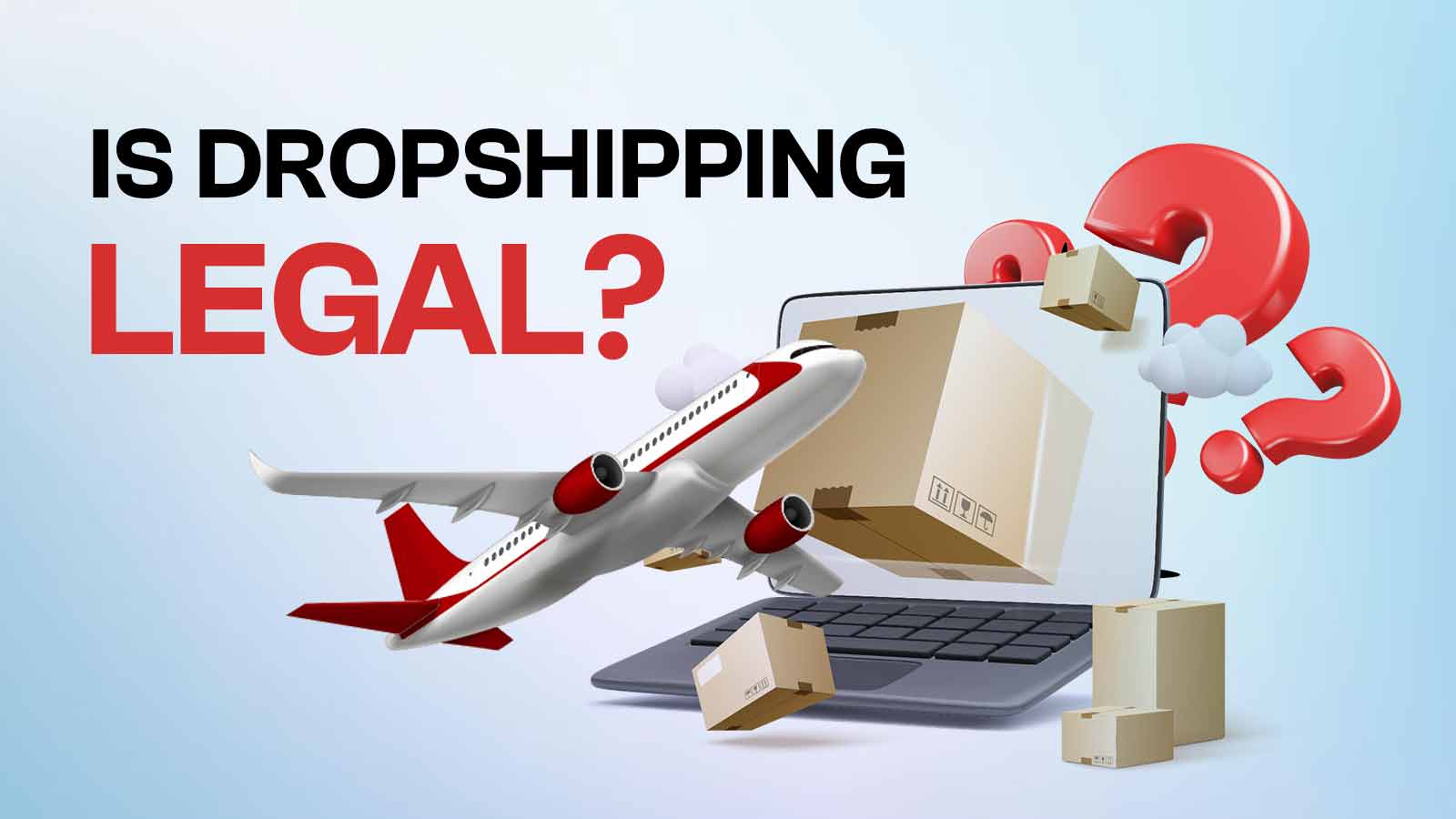
Is Dropshipping Legal? Potential Risks & Challenges Of Dropshipping
In the bustling world of e-commerce, dropshipping has emerged as a popular business model, offering entrepreneurs the allure of low overhead costs and minimal upfront investment. Yet, amidst its promises of profitability, a critical question looms: Is dropshipping legal?
Yes, dropshipping is legal. However, adherence to regulations and policies, such as those related to product sourcing, consumer protection, and intellectual property rights, is essential. Understanding the legal framework and complying with relevant laws are crucial for ethical and lawful dropshipping operations.
Join us as we explore the legal intricacies and navigate the potential hazards of dropshipping in today’s competitive marketplace.
What Is Dropshipping?

Dropshipping is a business strategy commonly used by online stores that do not maintain inventory. In this model, customers place orders for products listed on the storefront, and the retailer forwards these orders to the supplier or manufacturer. The supplier is responsible for inventory and shipping, while the retailer focuses on customer relationship management.
This approach benefits all parties involved, as suppliers can reach a broader market without extensive marketing efforts. At the same time, retailers can offer a diverse range of products without the burden of stocking inventory. Dropshipping is widely used by manufacturers, distributors, and online retailers worldwide to sell goods efficiently.
Is Dropshipping Legal?

Yes, dropshipping is legal. It’s a common business strategy where retailers sell products without maintaining inventory. Instead, when a customer orders, the retailer forwards it to the manufacturer or supplier, who ships the product directly to the buyer.
Adhering to state, federal, and international regulations governing the sale of goods is crucial for dropshipping businesses, just like any other business. With proper legal compliance, running a dropshipping company entails minimal personal responsibility risk. Consulting with an attorney can help establish legally binding contracts between you and your dropshipping partners, clarifying responsibilities in disputes regarding product sales, shipment, or consumer use.
How Does Dropshipping Work?

Dropshipping is a popular business model that allows entrepreneurs to start an e-commerce store without the need to hold inventory. Instead, the retailer (drop shipper) partners with a supplier or manufacturer who fulfills orders on their behalf. Let’s delve deeper into how dropshipping works, step by step.
1. Signing an Agreement with the Dropshipper:
The first step in the dropshipping process involves the retailer (seller) establishing a partnership with a dropshipper. This typically consists of signing an agreement outlining the terms and conditions of the partnership, including pricing, shipping arrangements, and product selection.
2. Customer Places an Order Online:
Once the retailer has set up their online store, customers browse the available products and place orders through the website. This can include selecting specific items and quantities and providing shipping information.
3. Seller Receives the Order:
Upon receiving an order, the seller is notified via their e-commerce platform or email. The order details, including the customer’s shipping address and selected products, are recorded for processing.
4. Customer Receives an Order Confirmation:
After placing an order, the customer receives an order confirmation email or notification confirming their purchase was successful. This communication reassures the customer and serves as a receipt for their purchase.
5. Seller Forwards the Order to the Dropshipper:
Once the order is received, the seller forwards the details to the dropshipper. This includes the customer’s shipping address and the specific products ordered. The drop shipper then prepares the order for shipment.
6. Dropshipper Ships the Order:
With the order details, the drop shipper packages the products and arranges shipping to the customer’s address. Depending on the drop shipper’s location and shipping method, this process may involve various carriers and logistics providers.
7. Customer Receives their Product:
Finally, the customer receives their order at the shipping address provided during checkout. The package typically includes the ordered products and any relevant documentation, such as packing slips or invoices.
Challenges of Dropshipping In 2024

Returns of Customer Products
Processing returns of customer products can be a significant challenge in dropshipping. Unlike traditional retail models where the seller holds inventory and manages returns directly, in dropshipping, returns often involve multiple parties, including the seller, dropshipper, and supplier.
Coordinating return logistics, handling refunds, and managing customer expectations can be complex and time-consuming. Ensuring timely communication and resolution of return requests is crucial for maintaining customer satisfaction and loyalty. Dropshippers must establish clear return policies, streamline processes, and maintain open communication channels with customers and suppliers to address return-related challenges effectively.
Building Brand Recognition Is Challenging
Building brand recognition in dropshipping can be challenging due to the need for more control over product packaging, branding, and customer experience. Since drop shippers rely on suppliers to fulfill orders, they often need more opportunities to customize packaging or include branded materials with shipments.
This can result in a generic customer experience that fails to leave a lasting impression or differentiate the brand from competitors. Additionally, competing in crowded marketplaces with established brands can make it difficult for drop shippers to stand out and gain visibility.
Overcoming these challenges requires innovative marketing strategies, consistent brand messaging, and a focus on delivering exceptional customer service to build trust and loyalty among target audiences.
Locating Bestsellers Store
Locating the bestsellers store can pose a challenge for dropshippers as it requires thorough market research and analysis to identify products with high demand and profit potential. With countless suppliers and products available, determining which items are trending and likely to generate sales can be time-consuming and daunting.
Additionally, competition among dropshippers vying for the same best-selling products further complicates the process. To overcome this challenge, drop shippers must leverage data analytics tools, monitor market trends, and establish relationships with reliable suppliers who offer sought-after products. By staying informed and adaptable, drop shippers can increase their chances of locating and capitalizing on bestsellers to drive revenue and growth in their e-commerce businesses.
Locating Trustworthy Vendors
Locating trustworthy vendors is a critical challenge in dropshipping, as suppliers’ reliability and reputation directly impact the business’s success. With numerous options available, identifying vendors who consistently deliver quality products, adhere to shipping timelines, and provide reliable customer service can take time and effort.
Dropshippers must conduct thorough due diligence, including researching vendor reviews, requesting samples, and communicating directly with potential suppliers to assess their professionalism and reliability. Additionally, verifying the legitimacy of vendors and ensuring compliance with industry standards and regulations are essential steps in mitigating risks associated with unreliable suppliers.
By investing time and effort into vetting vendors, dropshippers can establish long-term partnerships with trustworthy suppliers, fostering mutual trust and success in their dropshipping endeavours.
Prolonged Delivery Times and Delays Caused by Manually Importing
Prolonged delivery times and delays caused by manually importing products are common challenges drop shippers face. When products are sourced from international suppliers, manual import processes such as order processing, customs clearance, and shipping coordination can lead to extended delivery times and unexpected delays.
These delays impact customer satisfaction and increase the risk of negative reviews and order cancellations. To address this challenge, drop shippers can explore automation solutions, such as integrated software platforms and fulfillment services, to streamline import processes and expedite order fulfillment.
Additionally, maintaining transparent communication with customers regarding expected delivery times and potential delays can help manage expectations and mitigate the impact of prolonged delivery times on the overall customer experience.
Multiple Products
Managing multiple products can present challenges for dropshippers, particularly regarding inventory management, product selection, and marketing strategies. With a diverse range of products available, drop shippers must carefully curate their product offerings to align with their target market’s preferences and purchasing behaviors.
Additionally, effectively managing inventory levels and ensuring sufficient stock of each product can be complex, especially when dealing with fluctuating demand and supply chain disruptions. Furthermore, promoting multiple products requires strategic marketing efforts to effectively communicate the value proposition of each item and differentiate them from competitors.
By implementing robust inventory management systems, conducting market research, and developing targeted marketing campaigns, dropshippers can overcome the challenges associated with managing multiple products and maximize their e-commerce success.
Obtaining Top-Notch Products When Supplies Run Low
When supplies run low, obtaining top-notch products can be a significant challenge for dropshippers. When inventory levels diminish, sourcing high-quality products from reliable suppliers becomes imperative to maintain customer satisfaction and sustain business growth.
However, securing top-notch products during periods of low supply can be challenging due to increased competition and limited availability from suppliers. Drop shippers can explore alternative sourcing options to address this challenge, such as partnering with multiple suppliers or seeking new vendors with similar product offerings.
Additionally, fostering strong relationships with trusted suppliers and proactively communicating inventory needs can help prioritize replenishment efforts and ensure a steady supply of top-notch products to meet customer demand.
Unexpected Shifts in Product Pricing
Dealing with unexpected shifts in product pricing can pose a significant challenge for dropshippers. Cost fluctuations, such as changes in raw material prices, currency exchange rates, or supplier pricing policies, can directly impact profit margins and pricing strategies.
Moreover, sudden price increases may catch drop shippers off guard, leading to difficulties in maintaining competitive pricing and managing customer expectations. To mitigate this challenge, drop shippers must closely monitor market trends, establish transparent communication channels with suppliers, and regularly review pricing strategies to adapt to changes promptly.
Additionally, maintaining a buffer in pricing calculations and negotiating pricing agreements with suppliers can provide flexibility and resilience in the face of unexpected shifts in product pricing.
Keeping Supplier Accounts Free
Ensuring supplier accounts remain free from overdue balances and unpaid invoices is essential for smooth dropshipping operations. Managing supplier accounts effectively can become complex and time-consuming, with multiple suppliers and ongoing transactions.
However, overlooking overdue payments or unpaid invoices can strain supplier relationships and jeopardize future supply arrangements. To prevent this, drop shippers must implement robust accounting and payment tracking systems to monitor supplier accounts proactively.
Regularly reviewing payment schedules, promptly addressing payment discrepancies, and prioritizing timely payments can help maintain positive relationships with suppliers and ensure continued access to quality products for fulfilling customer orders.
Most Frequent Risks with Dropshipping Compliance

Ensuring compliance is paramount for any online business, even in dropshipping, where the business model itself is perfectly legal.
However, there are several areas where maintaining compliance is crucial to avoid potential risks and legal challenges.
- Consumer Protection Laws: Despite not manufacturing the products themselves, drop shippers are still responsible for ensuring the quality and safety of the items sold to consumers. To uphold consumer rights and mitigate liability, it’s essential to adhere to local consumer protection laws in the regions where products are sold.
- Copyright Laws: Dropshippers must avoid selling counterfeit or copyright-infringing products to prevent legal repercussions for intellectual property infringement. Vigilance is necessary to ensure that suppliers do not provide counterfeit items that could result in legal action for IP infringement.
- Licensing Laws: Obtaining necessary licenses, such as a sales tax permit and business license, is essential for dropshipping operations, particularly in the United States. Compliance with state requirements for sales tax permits is crucial to avoid penalties and maintain legal operation.
- Tax Laws: Dropshippers are subject to various taxes, including income tax, customs duties, and sales taxes. Compliance with tax laws, including proper collection and remittance of sales taxes, is essential to avoid penalties and legal issues related to tax evasion.
- Advertising Laws: Dropshippers must adhere to the truth in advertising laws by providing accurate descriptions of products to avoid misleading consumers. Misleading marketing campaigns can lead to legal trouble and damage the company’s reputation.
By following recommended practices and ensuring compliance with relevant laws and regulations, drop shippers can operate their businesses legitimately and mitigate the risks associated with non-compliance. Maintaining a proactive approach to compliance is essential for long-term success and legal stability in the dropshipping industry.
Is Dropshipping Legal On Amazon?

Dropshipping is indeed legal on Amazon, but it’s imperative to understand and adhere to Amazon’s regulations and standards to ensure compliance and maintain a positive seller reputation. Here are some key considerations when dropshipping on Amazon:
- Customer Service: Prompt and professional responses to customer inquiries, returns, and complaints are essential to maintaining favorable seller metrics on Amazon. Providing excellent customer service is crucial for sustaining success on the platform.
- Order Fulfillment: Sellers must meet Amazon’s performance requirements, including providing accurate tracking information and fulfilling orders promptly. A reliable fulfillment process ensures customer satisfaction and meets Amazon’s standards.
- Amazon Prime: To offer items with Amazon Prime benefits, such as free two-day delivery, sellers must meet Amazon’s criteria. Dropshippers must fulfill Prime orders from their inventories without an authorized fulfillment method.
- Product Listings: Detailed and accurate product descriptions that adhere to Amazon’s standards are essential. Include relevant details such as product features, specifications, and warranty information to give customers transparency.
- Sourcing High-Quality Products: Dropshippers are responsible for sourcing legitimate, high-quality products to sell on Amazon. Avoid offering counterfeit or infringing goods by purchasing from reputable vendors.
- Seller Agreement: Sellers must read and agree to Amazon’s Seller Agreement, which outlines the rules and regulations for selling on the platform. It’s essential to carefully review the agreement and ensure compliance with all rules and regulations.
Is Dropshipping Legal On AliExpress?

Dropshipping on AliExpress is legal, and many businesses thrive using this model. The platform is a popular marketplace for drop shippers to source a wide range of products from suppliers in China. However, before listing products on AliExpress, ensuring compliance with the platform’s terms of service and any applicable local laws is crucial.
AliExpress has specific rules and regulations governing product listings, seller behavior, and transaction processes. To maintain a positive reputation and avoid penalties or account suspensions, sellers must adhere to these guidelines. Also, drop shippers should know any legal requirements for product safety, labeling, and import regulations in their target markets.
By conducting thorough research and staying informed about AliExpress’s policies, dropshippers can operate their businesses legally and ethically on the platform. With proper adherence to regulations and a commitment to customer satisfaction, dropshipping on AliExpress can be a lucrative and sustainable venture.
Is Dropshipping Legal On eBay?

Yes, dropshipping is legal on eBay under specific conditions. If you own the products before listing them on eBay or directly agree with a wholesale supplier to sell their goods, you can use drop shipping. It’s important to note that using a user agreement from another marketplace or shop doesn’t meet these criteria.
When engaging in dropshipping on eBay, dealing directly with wholesale suppliers is crucial. Regardless of the dropshipping arrangement, sellers are ultimately responsible for ensuring the buyer’s satisfaction and the item’s safe arrival within the specified time limit. Adhering to eBay’s policies and maintaining transparency with buyers regarding shipping times and product details is essential for a legal and successful dropshipping operation on the platform.
Is Dropshipping Legal In The US?

Yes, dropshipping is perfectly legal in the United States. Many successful dropshipping businesses operate within the country’s borders. The dropshipping business model eliminates the need to hold inventory, as products are sourced directly from outside vendors and shipped straight to the buyer, bypassing the need for a middleman.
However, while dropshipping itself is legal, complying with all relevant US laws and regulations is essential. This includes:
- Business Registration: Depending on your location, you may need to register your company and obtain the necessary licenses or permits to operate legally.
- Consumer Protection: Adhere to rules and regulations regarding product descriptions, transparent return policies, and prompt resolution of customer complaints to ensure consumer protection.
- Advertising Regulations: Follow guidelines provided by the Federal Trade Commission (FTC) to avoid making deceptive or untrue statements in marketing materials or product descriptions.
How To Start Dropshipping Business From The Scratch?

Starting a dropshipping business from scratch can be an exciting venture, offering the potential for flexibility, scalability, and profitability. However, like any business endeavor, it requires careful planning, research, and execution.
1. Make Up Your Mind To Start A Dropshipping Business:
First and foremost, commit to the idea of creating a dropshipping business. Understand the advantages and challenges of this business model and ensure that you’re prepared to dedicate time, effort, and resources to make it successful.
2. Pick A Business Idea For Dropshipping:
Choose a niche or product category to focus on for your dropshipping business. Consider market demand, profit potential, and your interests and expertise when selecting a business idea.
3. Do Study On The Competition:
Conduct thorough research on your chosen niche and analyze the competition. Identify key competitors, understand their strengths and weaknesses, and look for gaps or opportunities you can capitalize on in the market.
4. Pick A Dropshipping Company:
Select a reputable dropshipping company or supplier to partner with. Look for suppliers that offer a wide range of products, competitive pricing, reliable shipping times, and excellent customer service.
5. Set Up Your Online Store:
Create an e-commerce website or store to showcase your products and facilitate transactions. Choose a user-friendly platform, such as Shopify, WooCommerce, or Magento, and customize your store to reflect your brand identity and appeal to your target audience.
6. Choose A Way To Run Your Business:
Decide on the operational aspects of your dropshipping business, including order processing, inventory management, and customer service. Determine whether you’ll handle these tasks manually or use automation tools and software to streamline operations.
7. Take Care Of Your Money:
Establish a budget for your dropshipping business and manage your finances carefully. Keep track of expenses, revenue, and profit margins, and reinvest profits into the business to fuel growth and expansion.
8. Send People To Your Dropshipping Shop:
Implement marketing strategies to drive traffic to your online store and attract potential customers. Utilize digital marketing tactics such as search engine optimization (SEO), social media marketing, email marketing, and pay-per-click advertising to reach your target audience and generate sales.
9. Look At Your Service And Make It Better:
Continuously monitor and evaluate your dropshipping business performance, including customer feedback, sales metrics, and market trends. Identify areas for improvement and make necessary adjustments to enhance the overall customer experience and grow your business.
FAQs
1. Is It Possible To Be Banned For Dropshipping?
Yes, it is possible to be banned or face restrictions on specific platforms if dropshipping policies are violated. Platforms like Amazon and eBay have particular rules, and failure to comply, such as providing inaccurate product information or violating intellectual property rights, can lead to suspension or ban. It’s crucial to thoroughly understand and adhere to the terms of service on the chosen platform to avoid such consequences.
2. Is It Okay To Dropship In The UK?
Dropshipping is allowed in the UK, and many businesses operate successfully using this model. However, similar to other regions, adherence to local laws, consumer protection regulations, and tax requirements is essential for legal and ethical operations.
3. If You Dropship, Is It A Risky Business?
Dropshipping can be a low-risk business model as it doesn’t require significant upfront investment in inventory. However, like any business, it comes with challenges, including supplier reliability, quality control, and intense competition. Success in dropshipping often depends on effective management and strategic decision-making.
4. Does Drop Shipping Make Money?
Yes, dropshipping has the potential to be a profitable venture. Success largely depends on niche selection, effective marketing, customer service, and choosing reliable suppliers. Many entrepreneurs have built successful businesses through dropshipping, which requires dedication and strategic planning.
5. What Do Most Drop Shippers Do Wrong?
Common mistakes among drop shippers include poor product research, choosing unreliable suppliers, neglecting customer service, and overlooking legal and ethical considerations. Successful dropshippers prioritize product quality, customer satisfaction, and transparent business practices.
6. How Likely Is It That Dropshipping Will Work In 2024?
The success of dropshipping in 2024, like any business, depends on various factors. Approximately 10-20% of dropshippers achieve significant success. To increase the likelihood of success, entrepreneurs should stay informed about industry trends, adapt to market changes, and focus on delivering value to customers.
7. How Long Does It Take To Make Money Dropshipping?
The time it takes to make money through dropshipping varies. Some entrepreneurs see profits within a few months, while others may take longer. Success is influenced by niche selection, marketing effectiveness, and the ability to build a reliable customer base. Patience, persistence, and continuous improvement are essential for long-term success in dropshipping.
Finally, Is Dropshipping Ethically Wrong?
Dropshipping itself is not inherently ethically wrong; its morality depends on how it is practiced. Ethical dropshippers prioritize honesty, quality, and fair business practices, contributing positively to the industry’s reputation. Conversely, unethical practices such as misleading marketing, selling counterfeit goods, or poor customer service can tarnish the image of dropshipping. Ultimately, individual dropshippers are responsible for upholding ethical standards in their business operations and striving to maintain integrity and transparency with their customers.

















































